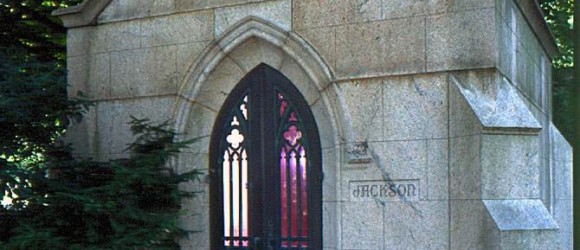Neo-Gothic Mausoleum
- At March 26, 2013
- By Doug Keister
- In Doug Keister's Blog
0

Perhaps no style of architecture is so closely associated with cemeteries as Gothic. Its towers, spires, and flying buttresses are the stuff of ghost stories, dark and stormy nights, and evil sorcerers. The structural advantages of the Gothic style over other types of architecture enabled architects and designers to construct buildings and cathedrals of any size their time and budgets would permit. Because Gothic architecture did not borrow heavily from any of the pagan Classical styles, it is most closely associated with Christianity. It is, in fact, the first purely Christian architecture. Gothic architecture is easy to identify by its vertical emphasis, pointed arches, and heavily ornamented spires.
Think of the great cathedrals in Europe and you’ll get a pretty good fix on the elements of the Gothic style. The style originated in France in the 12th century and lasted another four centuries before dying out in the 16th century. When the Gothic style was reintroduced in the 19th century it was known as Gothic revival.
Gothic architecture was not without its critics. In fact, the term Gothic was actually a derisive term uttered by the Italian architects who were developing a new style of their own: Italian Renaissance. When viewing the massive cathedrals that the French were building, the Italians were said to exclaim that the cathedrals were so ugly, only a Goth could possibly have built them; hence, the term Gothic.
Funerary architecture in the Gothic Revival style was somewhat more widely used in the nineteenth century than it is now, simply because of the significantly higher price to manufacture a heavily ornamented Gothic Revival monument or mausoleum. Another persistent problem is that the Gothic ornament can become a maintenance nightmare. The cracks, joints, and attachments are a magnet for ivy, nesting animals, and moisture.
However, beginning in the twentieth century, mausoleum designers and manufacturers began embracing a streamlined and refined Gothic style known as Neo-Gothic. Neo-Gothic retains the verticality plus the old world elegance and integrity of Gothic architecture without the maintenance problems. It is definitely a viable option for one who wants to deviate slightly from the Classical Revival norm and make a personal statement, often about their Christian religion.
Text and photo © Douglas Keister Visit Doug’s Author Page
